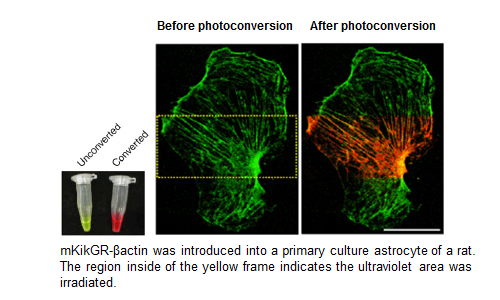Sep. 1, 2013
Photoconvertible fluorescent protein "mKikGR"
RIKEN No.: 06267
Inventors
Atsushi Miyawaki and Hideaki Mizuno (Laboratory for Cell Function Dynamics)
Background
Technologies to visualize biological molecules using fluorescent protein derived from aequorea victoria, coral or actinia are in widespread use. Current fluorescent imaging techniques have a drawback that they can provide fluorescent signal distribution under steady-state conditions but not dynamics of the molecule in microscopic observation. Kaede, developed by RIKEN, allows for specific marking of target cells any time. Kaede is characterized by its photoconversion from green to red fluorescence by illumination of ultraviolet.
Summary
The inventors modified a protein discovered from stony coral Favia favus and developed a photo-convertible fluorescent protein "mKikGR". mKikGR can change light absorption and fluorescence characteristics by ultraviolet light, and show its function as a monomer. mKikGR has an excitation peak at 505nm and an emission peak at 520nm, and emits green fluorescence. When irradiated with ultraviolet light, its excitation peak and emission peak shift to 360nm/580nm, and 590nm, respectively and it emits red fluorescence. Since mKikGR fluorescence exhibits a large separation of wavelength in emission peaks before and after photoconversion, green and red fluorescence can be detected easily in one cell. This photoconvertible property of mKikGR provides a powerful tool for analysis of protein behavior.

mKikGR before and after photoconversion
Merits
- A monomeric photoconvertible fluorescent for the analysis of the localization and behavior of target protein
Application
- Screening of medicines using behavior of biological molecules as an indicator
References
- 1.PCT/JP2004/008790, JP Patent No.4648834, US Patent No.7960530, EP Patent No.1640455, etc.
- 2.Tsutsui H, et al. EMBO Rep. 2005 Mar;6(3):233-8.; Habuchi S, et al. PLoS One. 2008;3(12):e3944.
- 3.Tsutsui H, et al. Chem Biol. 2009 Nov 25;16(11):1140-7.
